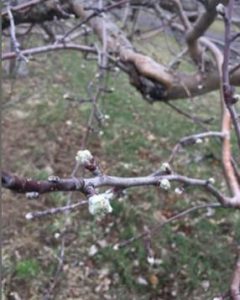April 13, 2017
Champlain Va lley orchards in Chittenden and Addison counties have reached the green tip bud stage on ‘McIntosh’ as of yesterday, April 12, which indicates that the growing season has begun for many Vermont orchards. Keep an eye out in your own orchards and plan on using actual green tip date as the starting biofix for scab models in NEWA and any other system that you might use to predict apple scab ascospore maturity. Apple scab can affect any green tissue on the plant at this time of year, but remember that ascospores, the overwintering inoculum that cause scab infections, mature in a typical bell-shaped curve with greatest spore maturity beginning after about 200 degree days (base 32°F) have accumulated from green tip. As I said last week, 2016 was extremely dry and scab was low in most Vermont orchards, so a small percentage of spores from a relatively smaller overwintering crop mean relatively low risk. Leaf wetness is needed to cause scab infection, and showers are expected over the weekend but not an extended, drawn out wetting event. So overall, scab risk is relatively low, but if you have high inoculum (i.e. had scab last year) and get a decent wetting event, you’ll need coverage before or during the weekend.
lley orchards in Chittenden and Addison counties have reached the green tip bud stage on ‘McIntosh’ as of yesterday, April 12, which indicates that the growing season has begun for many Vermont orchards. Keep an eye out in your own orchards and plan on using actual green tip date as the starting biofix for scab models in NEWA and any other system that you might use to predict apple scab ascospore maturity. Apple scab can affect any green tissue on the plant at this time of year, but remember that ascospores, the overwintering inoculum that cause scab infections, mature in a typical bell-shaped curve with greatest spore maturity beginning after about 200 degree days (base 32°F) have accumulated from green tip. As I said last week, 2016 was extremely dry and scab was low in most Vermont orchards, so a small percentage of spores from a relatively smaller overwintering crop mean relatively low risk. Leaf wetness is needed to cause scab infection, and showers are expected over the weekend but not an extended, drawn out wetting event. So overall, scab risk is relatively low, but if you have high inoculum (i.e. had scab last year) and get a decent wetting event, you’ll need coverage before or during the weekend.
Luckily, the answer to the “What should I do?” question is the same. At this point, even if you are still at silver tip in your orchard, it would be prudent to apply copper at a full rate to reduce fire blight (which was present in plenty of orchards, and likely wild hedgerow trees, last year) bacterial populations. This needs to go on prior to 1/2” green tip to prevent fruit russeting, which I have seen in certain years and which can immediately drop a perfectly good apple down to cider grade. This copper application will give you 5-7 days’ protection against apple scab. I would stick to the old standard copper materials like Champ, C-O-C-S, Cuprofix, Nucop, or Kocide and apply at the higher rates (in the 5-10 lbs per acre range usually, check your label). The new, low-rate coppers (e.g., Badge, Cueva) are better saved for summer use if you need them, as they don’t provide the value in terms of amount of copper ions per dollar that the older materials do.
Beginning next week we will start our orchard monitoring program by hanging tarnished plant bug and European apple sawfly traps in select orchards in the region. I’ll pull together some resources shortly for those who wish to ‘scout along’ with us in your own orchards. Until then, wrap up that pruning, push out the brush, and get the copper ready. Spring is here!
Where trade names or commercial products are used for identification,
no discrimination is intended and no endorsement is implied.
Always read the label before using any pesticide.
The label is the legal document for the product use.
Disregard any information in this message if it is in conflict with the
label.
The UVM Tree Fruit and Viticulture Program is supported by the
University of Vermont Agriculture Experiment Station, a USDA NIFA E-IPM
Grant, and USDA Risk Management Agency Funds.
